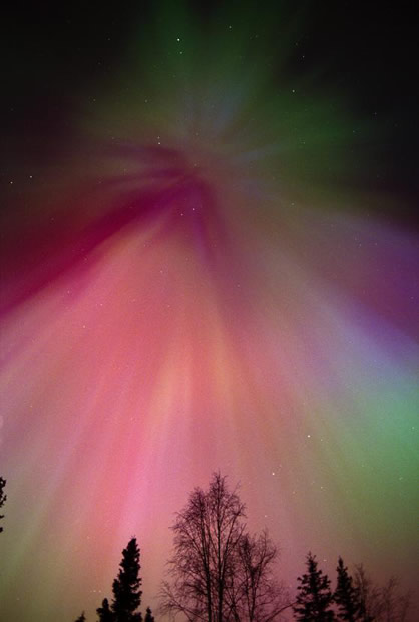Auroral corona, Alaska
Auroral Corona: A Magnificent Display in Alaska
The phenomenon of auroral corona in Alaska is a breathtaking display of nature's beauty. When observing the aurora borealis, or northern lights, one may occasionally witness the convergence of the auroral rays, creating a crown-like shape known as the auroral corona. While the rays themselves are generally parallel and upward-going, perspective effects can give the illusion of them converging to form this stunning corona.
The auroral corona is enhanced by the presence of atomic oxygen and possibly some high nitrogen molecular ion emissions. These atmospheric elements contribute to the vibrant colors and intricate patterns seen within the corona. The interaction between charged particles from the Sun and the Earth's magnetic field leads to this captivating light show.
Photographer Jan Curtis captured a mesmerizing image of the auroral corona in Alaska, showcasing its grandeur. The photograph reveals the ethereal nature of the corona, with its delicate, crown-like structure radiating from a central point. The image serves as a testament to the captivating beauty of the natural world.
To fully appreciate the auroral corona in Alaska, it is important to understand the scientific processes behind this phenomenon. The northern lights occur when charged particles from the Sun, such as electrons and protons, collide with atoms and molecules in Earth's atmosphere. These collisions excite the atoms and molecules, causing them to emit light of various colors.
The specific colors observed in the aurora depend on the type of gas present in the atmosphere and the altitude at which the collisions occur. For example, oxygen molecules at high altitudes emit green light, while oxygen atoms at lower altitudes emit red light. Nitrogen molecules can also contribute to the color spectrum, producing hues of blue and purple.
The convergence of auroral rays into an auroral corona is an optical illusion caused by perspective effects. When viewing the lights from a certain angle, the parallel rays appear to converge towards a central point, creating the illusion of a crown or corona. This phenomenon adds an extra layer of visual intrigue to the already mesmerizing display of the aurora borealis.
The auroral corona is not limited to Alaska alone; it can be observed in other regions near the polar latitudes as well. However, Alaska's geographical location and proximity to the North Pole make it an ideal location for witnessing this awe-inspiring spectacle. The clear, dark skies of Alaska, away from light pollution, provide the perfect backdrop for the vibrant colors and intricate patterns of the auroral corona to shine through.
Experiencing the auroral corona in person is a truly unforgettable experience. Standing beneath the dancing lights, one cannot help but feel a sense of wonder and awe at the beauty and grandeur of nature. It serves as a reminder of the vastness and complexity of the universe we inhabit.
In conclusion, the auroral corona in Alaska is a remarkable phenomenon that showcases the beauty and power of nature. Its crown-like shape, created by the convergence of parallel auroral rays, adds an extra layer of visual intrigue to the already mesmerizing display of the northern lights. With its vibrant colors and intricate patterns, the auroral corona is a testament to the scientific processes occurring in Earth's atmosphere. Witnessing this awe-inspiring spectacle in person is an experience that will leave a lasting impression and remind us of the wonders that exist beyond our everyday lives.

Auroral Corona, Alaska
Photographed by Jan Curtis (Aurora site).
Auroral rays are more or less parallel to each other and upward going. Perspective effects can make them appear to converge to a crown or corona.
Atomic oxygen and possibly some high nitrogen molecular ion emissions feature in this magnificent display.
Image ©Jan Curtis, shown with permission.
Note: this article has been automatically converted from the old site and may not appear as intended. You can find the original article here.
Reference Atmospheric Optics
If you use any of the definitions, information, or data presented on Atmospheric Optics, please copy the link or reference below to properly credit us as the reference source. Thank you!
-
<a href="https://atoptics.co.uk/blog/auroral-corona-alaska/">Auroral corona, Alaska</a>
-
"Auroral corona, Alaska". Atmospheric Optics. Accessed on December 22, 2024. https://atoptics.co.uk/blog/auroral-corona-alaska/.
-
"Auroral corona, Alaska". Atmospheric Optics, https://atoptics.co.uk/blog/auroral-corona-alaska/. Accessed 22 December, 2024
-
Auroral corona, Alaska. Atmospheric Optics. Retrieved from https://atoptics.co.uk/blog/auroral-corona-alaska/.